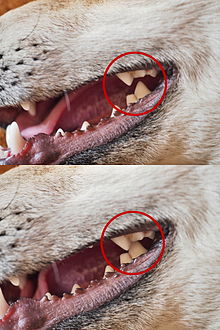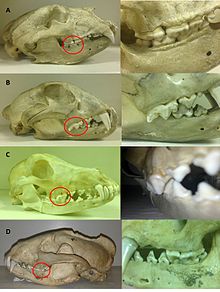Carnassial

Carnassials are paired upper and lower teeth modified in such a way as to allow enlarged and often self-sharpening edges to pass by each other in a shearing manner. This adaptation is found in
Taxonomy
The name carnivoran is applied to a member of the order
Carnassial dentition
Right: Carnassial teeth of [E] otter (Lutra), [F] raccoon (Procyon), [G] mongoose (Herpestes), [H] weasel (Mustela), and their respective close-ups.
Photos taken at Imperial College London.
Carnassial teeth are modified molars (and in the case of carnivorans premolars) which are adapted to allow for the shearing (rather than tearing) of flesh to permit the more efficient consumption of meat. These modifications are not limited to the members of the order Carnivora, but are seen in a number of different mammal groups.[citation needed] Not all carnivorous mammals, however, developed carnassial teeth. Mesonychids, for example, had no carnassial adaptations, and as a result, the blunt, rounded cusps on its molars had a much more difficult time reducing meat.[3] Likewise, neither members of Oxyclaenidae nor Arctocyonidae had carnassial teeth.[4]
On the other hand, carnivorous marsupials have teeth of a carnassial form. Both the living

Creodonts have two or three pairs of carnassial teeth, but only one pair performed the cutting function: either M1/m2 or M2/m3, depending on the family.[8] In Oxyaenidae, it is M1 and m2 that form the carnassials. Among the hyaenodontids it is M2 and m3. Unlike most modern carnivorans, in which the carnassials are the sole shearing teeth, in the creodonts other molars have a subordinate shearing function.[9] The fact that the two lineages developed carnassials from different types of teeth has been used as evidence against the validity of Creodonta as a clade.[10][11][12]
Modern carnivorous bats generally lack true carnassial teeth, but the extinct Necromantis had particularly convergent teeth, in particular M1 and M2, which bore expanded heels and broad stylar shelves. These were particularly suited for crushing over an exclusively slicing action.[13]
Though not superficially similar, the triconodont teeth of some early mammals such as
In modern carnivorans the carnassial teeth pairs are found on either side of the jaw and are composed of the fourth upper pre-molar and the first lower molar (P4/m1).
The scissor-like motion is created by the movement between the carnassial pair when the jaw occludes. The inside of the fourth upper pre-molar closely passes by the outer surface of the first lower molar, thus allowing the sharp cusps of the carnassial teeth to slice through meat.
The length and size of the carnassial teeth vary between species, taking into account factors such as:[19]
- the size of the carnivorous animal
- the extent to which the diet is carnivorous
- the size of the chunk of meat that can be swallowed.
Evolution of carnassial teeth

The
The shape and size of sectorial teeth of different carnivorous animals vary depending on diet, illustrated by the comparisons of bear (Ursus) carnassials with those of a leopard (Panthera). Bears, being
Disease
Wear and cracking of the carnassial teeth in a wild carnivore (e.g. a wolf or lion) may result in the death of the individual due to starvation.
Carnassial teeth infections are common in domestic dogs. They can present as
References
- ^ Osborn, Henry Fairfield (1907). Evolution of mammalian molar teeth. Macmillan. p. 11. Retrieved 20 January 2011.
- OCLC 502410693.
- ISBN 978-0-231-15893-0.
- ^ Wortman, Jacob Lawson (May 1901). "Studies of Eocene Mammalia in the Marsh Collection, Peabody Museum," American Journal of Science 11 reprinted in Wortman, Jacob Lawson (1899). "Collected Papers". n.p. p. 285.
- ^ Ettelson, Zara Henrietta (March 1915). "Essay: A Brief Outline of the Teeth of Marsupialia". Northwestern Dental Journal. pp. 13–15.
- .
- ^ Marshall, Larry G. (1978). "Evolution of the Borhyaenidae, Extinct South American Predaceous Marsupials". University of California Publications in Geological Sciences. 117: 10–12.
- ISBN 0-521-35519-2.
- hdl:2246/5744. The discussion concerning creodont carnassials is found at page 321.
- ^ Matthew, William Diller (August 1909). "The Carnivora and Insectivora of the Bridger Basin, Middle Eocene". Memoirs of the American Museum of Natural History 9. pp. 289–576.
- ^ Morlo, M., Gunnell G., and P.D. Polly. 2009. What, if not nothing, is a creodont? Phylogeny and classification of Hyaenodontida and other former creodonts. Journal of Vertebrate Paleontology 29(Supplement 3): 152A.
- ^ Polly, P.D. 1994. What, if anything, is a creodont? Journal of Vertebrate Paleontology 14(Supplement 3): 42A.
- ISBN 978-0-521-76824-5
- ISBN 0-231-11918-6.
- S2CID 16357353.
- ^ https://assets.researchsquare.com/files/rs-1094239/v1/12dd4c6b-5ed0-4512-b773-e82d7372f339.pdf?c=1638288819 [bare URL PDF]
- ISBN 978-0-8018-8695-9.
- doi:10.1086/272297.
- ^ Savage, R.J.G. (1977). "Evolution in carnivorous mammals". Palaeontology. 20: 237–271.
- ^ "Natural History Collections: Carnivores". The Natural History Collections of the University of Edinburgh. Retrieved 2017-11-18.
- S2CID 14039133.
- ^ "Taking the bite out of tooth extractions". 19 July 2016.


